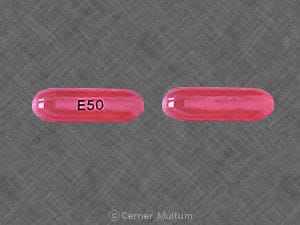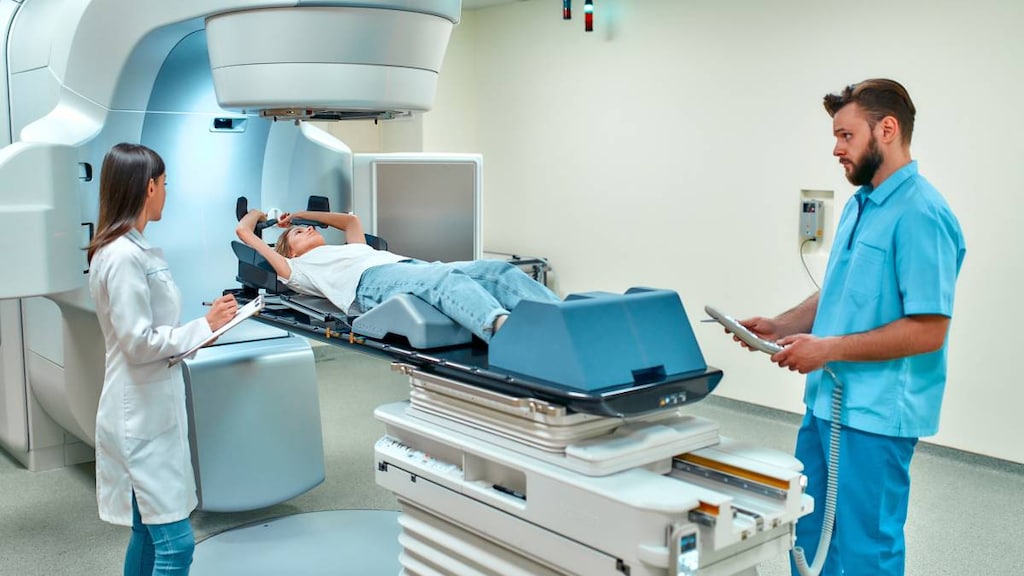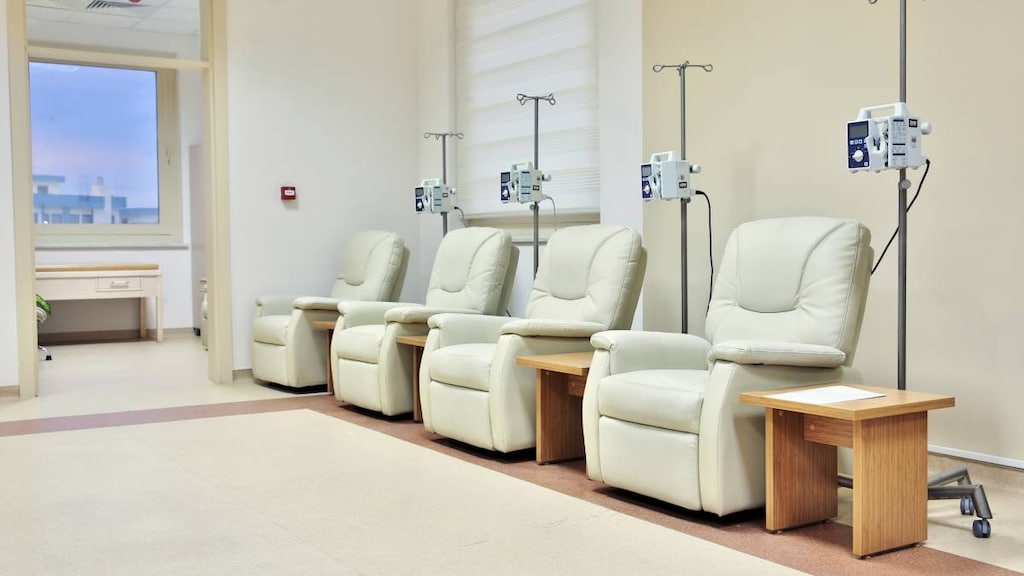Dosage Forms
Excipient information presented when available (limited, particularly for generics); consult specific product labeling.
Solution Reconstituted, Intravenous [strength expressed as base, preservative free]:
Etopophos: 100 mg (1 ea) [contains dextran 40]
Pharmacology
Mechanism of Action
Etoposide phosphate is converted in vivo to the active moiety, etoposide, by dephosphorylation. Etoposide inhibits mitotic activity; inhibits cells from entering prophase; inhibits DNA synthesis. Initially thought to be mitotic inhibitors similar to podophyllotoxin, but actually have no effect on microtubule assembly. However, later shown to induce DNA strand breakage and inhibition of topoisomerase II (an enzyme which breaks and repairs DNA); etoposide acts in late S or early G2 phases.
Pharmacokinetics/Pharmacodynamics
Distribution
Vd (mean): 18 to 29 L; poor penetration across blood-brain barrier
Metabolism
Etoposide phosphate: Rapidly and completely converted to etoposide in plasma
Etoposide: Hepatic, via CYP3A4 and 3A5 to various metabolites; in addition, conversion of etoposide to the O-demethylated metabolites (catechol and quinine) via prostaglandin synthases or myeloperoxidase occurs, as well as glutathione and glucuronide conjugation via GSTT1/GSTP1 and UGT1A1 (Yang 2009)
Excretion
Urine (56%; 45% as etoposide, ≤8% as metabolites) within 120 hours; feces (44%) within 120 hours
Half-Life Elimination
Terminal: 4 to 11 hours; Children: Normal renal/hepatic function: 6 to 8 hours
Protein Binding
97% (primarily to albumin)
Use in Specific Populations
Special Populations: Renal Function Impairment
Total body clearance is correlated with creatinine clearance.
Use: Labeled Indications
Small cell lung cancer: First-line treatment of small cell lung cancer (in combination with cisplatin)
Testicular cancer, refractory: Treatment of refractory testicular tumors (in combination with other chemotherapy agents)
Contraindications
Severe hypersensitivity to etoposide products or any component of the formulation
Dosage and Administration
Dosing: Adult
Note: Etoposide phosphate is a prodrug of etoposide; equivalent doses should be used when converting from etoposide to etoposide phosphate. Each 100 mg vial of etoposide phosphate is equivalent to 100 mg of etoposide.
Small cell lung cancer: IV: Etoposide 35 mg/m2/day for 4 days or 50 mg/m2/day for 5 days every 21 to 28 days (in combination with cisplatin). According to American Society of Clinical Oncology (ASCO) guidelines, platinum-based therapy (cisplatin or carboplatin) in combination with either etoposide or irinotecan for 4 to 6 cycles is recommended over other regimens for limited stage or extensive stage disease (4 cycles preferred for limited stage) (Rudin 2015).
Testicular cancer, refractory (in combination with other approved chemotherapeutic agents): IV: Etoposide 50 to 100 mg/m2/day on days 1 to 5 every 21 to 28 days or 100 mg/m2/day on days 1, 3, and 5 every 21 to 28 days.
Indication-specific off-label dosing: Refer to Etoposide monograph.
Dosing: Geriatric
Refer to adult dosing.
Dosing: Adjustment for Toxicity
Hematologic (ANC <500/mm3 and/or platelets <50,000/mm3): Interrupt treatment until blood counts have sufficiently recovered.
Severe adverse reactions: Reduce dose, interrupt treatment, or discontinue.
Dosing: Obesity
ASCO Guidelines for appropriate chemotherapy dosing in obese adults with cancer (Note: Excludes HSCT dosing): Utilize patient's actual body weight (full weight) for calculation of body surface area- or weight-based dosing, particularly when the intent of therapy is curative; manage regimen-related toxicities in the same manner as for nonobese patients; if a dose reduction is utilized due to toxicity, consider resumption of full weight-based dosing with subsequent cycles, especially if cause of toxicity (eg, hepatic or renal impairment) is resolved (Griggs 2012).
Reconstitution
Reconstitute vials with 5 mL or 10 mL SWFI, D5W, NS, bacteriostatic water for injection with benzyl alcohol, or bacteriostatic sodium chloride for injection with benzyl alcohol to a concentration of 20 mg/mL or 10 mg/mL etoposide equivalent. These solutions may be administered without further dilution or may be diluted in D5W or NS to a concentration as low as 0.1 mg/mL.
Administration
IV: Small cell lung cancer, testicular cancer (refractory): Infuse over 5 minutes to 3.5 hours. Do not administer as an IV bolus over less than 5 minutes. Etoposide phosphate may be an irritant; monitor infusion site; avoid extravasation.
Storage
Store intact vials at 2°C to 8°C (36°F to 46°F). Retain in original package to protect from light. Reconstituted solution is stable for 7 days refrigerated at 2°C to 8°C (36°F to 46°F). Reconstituted solutions are stable at room temperature for 24 hours when reconstituted with SWFI, D5W, or NS, or for 48 hours when reconstituted with bacteriostatic water for injection with benzyl alcohol or bacteriostatic sodium chloride for injection with benzyl alcohol. Solutions diluted for infusion are stable for up to 24 hours at room temperature 20°C to 25°C (68°F to 77°F) or under refrigeration 2°C to 8°C (36°F to 46°F).
Etoposide Phosphate Images
Drug Interactions
Atovaquone: May increase the serum concentration of Etoposide Phosphate. Management: Consider separating the administration of atovaquone and etoposide by at least 1 to 2 days. Monitor therapy
Baricitinib: Immunosuppressants may enhance the immunosuppressive effect of Baricitinib. Management: Use of baricitinib in combination with potent immunosuppressants such as azathioprine or cyclosporine is not recommended. Concurrent use with antirheumatic doses of methotrexate or nonbiologic disease modifying antirheumatic drugs (DMARDs) is permitted. Consider therapy modification
BCG (Intravesical): Immunosuppressants may diminish the therapeutic effect of BCG (Intravesical). Avoid combination
BCG (Intravesical): Myelosuppressive Agents may diminish the therapeutic effect of BCG (Intravesical). Avoid combination
Bosentan: May decrease the serum concentration of CYP3A4 Substrates (High risk with Inducers). Monitor therapy
Chloramphenicol (Ophthalmic): May enhance the adverse/toxic effect of Myelosuppressive Agents. Monitor therapy
Cladribine: May enhance the immunosuppressive effect of Immunosuppressants. Avoid combination
Cladribine: May enhance the myelosuppressive effect of Myelosuppressive Agents. Avoid combination
CloZAPine: Myelosuppressive Agents may enhance the adverse/toxic effect of CloZAPine. Specifically, the risk for neutropenia may be increased. Monitor therapy
Coccidioides immitis Skin Test: Immunosuppressants may diminish the diagnostic effect of Coccidioides immitis Skin Test. Monitor therapy
CycloSPORINE (Systemic): May increase the serum concentration of Etoposide Phosphate. CycloSPORINE may decrease the metabolism, via CYP isoenzymes, and decrease the p-glycoprotein-mediated elimination of Etoposide Phosphate. Consider therapy modification
CYP3A4 Inducers (Moderate): May decrease the serum concentration of CYP3A4 Substrates (High risk with Inducers). Monitor therapy
CYP3A4 Inducers (Strong): May decrease the serum concentration of Etoposide Phosphate. Management: When possible, seek alternatives to strong CYP3A4-inducing medications in patients receiving etoposide phosphate. If these combinations cannot be avoided, monitor patients closely for diminished etoposide phosphate response. Consider therapy modification
Dabrafenib: May decrease the serum concentration of CYP3A4 Substrates (High risk with Inducers). Management: Seek alternatives to the CYP3A4 substrate when possible. If concomitant therapy cannot be avoided, monitor clinical effects of the substrate closely (particularly therapeutic effects). Consider therapy modification
Deferasirox: May decrease the serum concentration of CYP3A4 Substrates (High risk with Inducers). Monitor therapy
Deferiprone: Myelosuppressive Agents may enhance the neutropenic effect of Deferiprone. Management: Avoid the concomitant use of deferiprone and myelosuppressive agents whenever possible. If this combination cannot be avoided, monitor the absolute neutrophil count more closely. Consider therapy modification
Denosumab: May enhance the adverse/toxic effect of Immunosuppressants. Specifically, the risk for serious infections may be increased. Monitor therapy
Dipyrone: May enhance the adverse/toxic effect of Myelosuppressive Agents. Specifically, the risk for agranulocytosis and pancytopenia may be increased Avoid combination
Enzalutamide: May decrease the serum concentration of CYP3A4 Substrates (High risk with Inducers). Management: Concurrent use of enzalutamide with CYP3A4 substrates that have a narrow therapeutic index should be avoided. Use of enzalutamide and any other CYP3A4 substrate should be performed with caution and close monitoring. Consider therapy modification
Erdafitinib: May decrease the serum concentration of CYP3A4 Substrates (High risk with Inducers). Monitor therapy
Erdafitinib: May increase the serum concentration of P-glycoprotein/ABCB1 Substrates. Monitor therapy
Fingolimod: Immunosuppressants may enhance the immunosuppressive effect of Fingolimod. Management: Avoid the concomitant use of fingolimod and other immunosuppressants when possible. If combined, monitor patients closely for additive immunosuppressant effects (eg, infections). Consider therapy modification
Ivosidenib: May decrease the serum concentration of CYP3A4 Substrates (High risk with Inducers). Monitor therapy
Lasmiditan: May increase the serum concentration of P-glycoprotein/ABCB1 Substrates. Avoid combination
Leflunomide: Immunosuppressants may enhance the adverse/toxic effect of Leflunomide. Specifically, the risk for hematologic toxicity such as pancytopenia, agranulocytosis, and/or thrombocytopenia may be increased. Management: Consider not using a leflunomide loading dose in patients receiving other immunosuppressants. Patients receiving both leflunomide and another immunosuppressant should be monitored for bone marrow suppression at least monthly. Consider therapy modification
Lenograstim: Antineoplastic Agents may diminish the therapeutic effect of Lenograstim. Management: Avoid the use of lenograstim 24 hours before until 24 hours after the completion of myelosuppressive cytotoxic chemotherapy. Consider therapy modification
Lipegfilgrastim: Antineoplastic Agents may diminish the therapeutic effect of Lipegfilgrastim. Management: Avoid concomitant use of lipegfilgrastim and myelosuppressive cytotoxic chemotherapy. Lipegfilgrastim should be administered at least 24 hours after the completion of myelosuppressive cytotoxic chemotherapy. Consider therapy modification
Lorlatinib: May decrease the serum concentration of CYP3A4 Substrates (High risk with Inducers). Management: Avoid concurrent use of lorlatinib with any CYP3A4 substrates for which a minimal decrease in serum concentrations of the CYP3A4 substrate could lead to therapeutic failure and serious clinical consequences. Consider therapy modification
Mesalamine: May enhance the myelosuppressive effect of Myelosuppressive Agents. Monitor therapy
Mitotane: May decrease the serum concentration of CYP3A4 Substrates (High risk with Inducers). Management: Doses of CYP3A4 substrates may need to be adjusted substantially when used in patients being treated with mitotane. Consider therapy modification
Natalizumab: Immunosuppressants may enhance the adverse/toxic effect of Natalizumab. Specifically, the risk of concurrent infection may be increased. Avoid combination
Nivolumab: Immunosuppressants may diminish the therapeutic effect of Nivolumab. Consider therapy modification
Ocrelizumab: May enhance the immunosuppressive effect of Immunosuppressants. Monitor therapy
Palifermin: May enhance the adverse/toxic effect of Antineoplastic Agents. Specifically, the duration and severity of oral mucositis may be increased. Management: Do not administer palifermin within 24 hours before, during infusion of, or within 24 hours after administration of myelotoxic chemotherapy. Consider therapy modification
P-glycoprotein/ABCB1 Inducers: May decrease the serum concentration of P-glycoprotein/ABCB1 Substrates. P-glycoprotein inducers may also further limit the distribution of p-glycoprotein substrates to specific cells/tissues/organs where p-glycoprotein is present in large amounts (e.g., brain, T-lymphocytes, testes, etc.). Monitor therapy
P-glycoprotein/ABCB1 Inhibitors: May increase the serum concentration of P-glycoprotein/ABCB1 Substrates. P-glycoprotein inhibitors may also enhance the distribution of p-glycoprotein substrates to specific cells/tissues/organs where p-glycoprotein is present in large amounts (e.g., brain, T-lymphocytes, testes, etc.). Monitor therapy
Pidotimod: Immunosuppressants may diminish the therapeutic effect of Pidotimod. Monitor therapy
Pimecrolimus: May enhance the adverse/toxic effect of Immunosuppressants. Avoid combination
Promazine: May enhance the myelosuppressive effect of Myelosuppressive Agents. Monitor therapy
Ranolazine: May increase the serum concentration of P-glycoprotein/ABCB1 Substrates. Monitor therapy
Roflumilast: May enhance the immunosuppressive effect of Immunosuppressants. Consider therapy modification
Sarilumab: May decrease the serum concentration of CYP3A4 Substrates (High risk with Inducers). Monitor therapy
Siltuximab: May decrease the serum concentration of CYP3A4 Substrates (High risk with Inducers). Monitor therapy
Siponimod: Immunosuppressants may enhance the immunosuppressive effect of Siponimod. Monitor therapy
Sipuleucel-T: Immunosuppressants may diminish the therapeutic effect of Sipuleucel-T. Management: Evaluate patients to see if it is medically appropriate to reduce or discontinue therapy with immunosuppressants prior to initiating sipuleucel-T therapy. Consider therapy modification
Smallpox and Monkeypox Vaccine (Live): Immunosuppressants may diminish the therapeutic effect of Smallpox and Monkeypox Vaccine (Live). Monitor therapy
Tacrolimus (Topical): May enhance the adverse/toxic effect of Immunosuppressants. Avoid combination
Tertomotide: Immunosuppressants may diminish the therapeutic effect of Tertomotide. Monitor therapy
Tocilizumab: May decrease the serum concentration of CYP3A4 Substrates (High risk with Inducers). Monitor therapy
Tofacitinib: Immunosuppressants may enhance the immunosuppressive effect of Tofacitinib. Management: Concurrent use with antirheumatic doses of methotrexate or nonbiologic disease modifying antirheumatic drugs (DMARDs) is permitted, and this warning seems particularly focused on more potent immunosuppressants. Consider therapy modification
Trastuzumab: May enhance the neutropenic effect of Immunosuppressants. Monitor therapy
Upadacitinib: Immunosuppressants may enhance the immunosuppressive effect of Upadacitinib. Avoid combination
Vaccines (Inactivated): Immunosuppressants may diminish the therapeutic effect of Vaccines (Inactivated). Management: Vaccine efficacy may be reduced. Complete all age-appropriate vaccinations at least 2 weeks prior to starting an immunosuppressant. If vaccinated during immunosuppressant therapy, revaccinate at least 3 months after immunosuppressant discontinuation. Consider therapy modification
Vaccines (Live): Immunosuppressants may enhance the adverse/toxic effect of Vaccines (Live). Immunosuppressants may diminish the therapeutic effect of Vaccines (Live). Management: Avoid use of live organism vaccines with immunosuppressants; live-attenuated vaccines should not be given for at least 3 months after immunosuppressants. Exceptions: Smallpox and Monkeypox Vaccine (Live). Avoid combination
Vitamin K Antagonists (eg, warfarin): Etoposide Phosphate may enhance the anticoagulant effect of Vitamin K Antagonists. Monitor therapy
Adverse Reactions
Also see adverse reactions for etoposide; etoposide phosphate is converted to etoposide, adverse reactions experienced with etoposide would also be expected with etoposide phosphate.
Frequency not defined:
Central nervous system: Seizure, unusual taste
Dermatologic: Skin abnormalities related to radiation recall, skin pigmentation, Stevens-Johnson syndrome, toxic epidermal necrolysis
Gastrointestinal: Abdominal pain, constipation, dysphagia, nausea, vomiting
Hematologic & oncologic: Bone marrow depression, major hemorrhage (life-threatening), neutropenia, secondary acute myelocytic leukemia, thrombocytopenia
Hepatic: Hepatotoxicity
Hypersensitivity: Anaphylaxis, hypersensitivity reaction
Infection: Infection
Ophthalmic: Cortical blindness (transient), optic neuritis
Respiratory: Interstitial pneumonitis, pulmonary fibrosis
Miscellaneous: Fever
<1%, postmarketing, and/or case reports: Extravasation injury
Warnings/Precautions
Concerns related to adverse effects:
- Bone marrow suppression: Etoposide phosphate is associated with hematologic toxicity, including neutropenia and thrombocytopenia. The nadir typically occurs at 10 to 14 days with recovery by day 21 (Perry 2012). Infections due to neutropenia and bleeding due to thrombocytopenia have occurred, some fatal. Monitor blood counts prior to each cycle of etoposide phosphate and more frequently if needed.
- Hypersensitivity: Etoposide phosphate may cause hypersensitivity reactions, including rash, pruritus, urticaria, and anaphylaxis. Interrupt therapy immediately and begin supportive management if hypersensitivity reactions occur. Discontinue permanently in patients with severe hypersensitivity reactions. Underlying mechanisms behind the development of hypersensitivity reactions is unknown, but have been attributed to high drug concentration and rate of infusion. Another possible mechanism may be due to the differences between available etoposide intravenous formulations. Etoposide intravenous formulation contains polysorbate 80 and benzyl alcohol, while etoposide phosphate (the water soluble prodrug of etoposide) intravenous formulation does not contain either vehicle. Case reports have suggested that etoposide phosphate has been used successfully in patients with previous hypersensitivity reactions to etoposide (Collier 2008; Siderov 2002).
- Renal failure: Acute renal failure (reversible) may occur when high etoposide phosphate doses (2,220 mg/m2) and total body irradiation are used for hematopoietic stem cell transplant (usually occurred in children). Monitor renal function before and after etoposide phosphate therapy until complete renal function recovery.
- Reproductive effects: Etoposide phosphate may result in infertility in male and female patients. Oligospermia, azoospermia, and permanent loss of fertility may occur in males; amenorrhea and premature menopause may also occur in women.
- Secondary malignancies: Secondary leukemias have been reported with long-term use of etoposide phosphate.
Disease-related concerns:
- Hepatic impairment: Use with caution in patients with hepatic impairment; may require dosage adjustment.
- Renal impairment: Use with caution in patients with renal impairment; may require dosage adjustment.
Concurrent drug therapy issues:
- Drug-drug interactions: Potentially significant interactions may exist, requiring dose or frequency adjustment, additional monitoring, and/or selection of alternative therapy. Consult drug interactions database for more detailed information.
Other warnings/precautions:
- Conversion: Each 100 mg vial of etoposide phosphate is equivalent to 100 mg of etoposide. Equivalent doses should be used when converting from etoposide to etoposide phosphate.
Monitoring Parameters
CBC with differential and platelets (prior to each cycle; more frequently if necessary), bilirubin, AST/ALT, renal function (before and after administration until complete renal function recovery), vital signs (blood pressure)
Pregnancy
Pregnancy Considerations
Based on animal reproduction studies and the mechanism of action, etoposide phosphate may cause fetal harm if administered during pregnancy. Fetal growth restriction and newborn myelosuppression have been observed following maternal use of regimens containing etoposide during pregnancy (NTP 2013; Peccatori 2013). Females of reproductive potential should avoid pregnancy during treatment.
The European Society for Medical Oncology has published guidelines for diagnosis, treatment, and follow-up of cancer during pregnancy. The guidelines recommend referral to a facility with expertise in cancer during pregnancy and encourage a multidisciplinary team (obstetrician, neonatologist, oncology team). In general, if chemotherapy is indicated, it should be avoided during in the first trimester, there should be a 3-week time period between the last chemotherapy dose and anticipated delivery, and chemotherapy should not be administered beyond week 33 of gestation. Guidelines for the treatment of SCLC are not provided (Peccatori 2013).
In females of reproductive potential, etoposide phosphate may cause amenorrhea, infertility, or premature menopause; effective contraception should be used during therapy and for at least 6 months after the last dose. In males, azoospermia, oligospermia, or permanent loss of fertility may occur. In addition, spermatozoa and testicular tissue may be damaged. Males with female partners of reproductive potential should use condoms during therapy and for 4 months after the last dose.
A pregnancy registry is available for all cancers diagnosed during pregnancy at Cooper Health (877-635-4499).
Patient Education
- Discuss specific use of drug and side effects with patient as it relates to treatment. (HCAHPS: During this hospital stay, were you given any medicine that you had not taken before? Before giving you any new medicine, how often did hospital staff tell you what the medicine was for? How often did hospital staff describe possible side effects in a way you could understand?)
- Patient may experience nausea, vomiting, abdominal pain, constipation, or change in taste. Have patient report immediately to prescriber signs of infection, signs of a severe pulmonary disorder (lung or breathing problems like difficulty breathing, shortness of breath, or a cough that is new or worse), signs of liver problems (dark urine, fatigue, lack of appetite, nausea, abdominal pain, light-colored stools, vomiting, or yellow skin), signs of kidney problems (unable to pass urine, blood in the urine, change in amount of urine passed, or weight gain), skin discoloration, vision changes, seizures, severe loss of strength and energy, bruising, bleeding, blindness, signs of Stevens-Johnson syndrome/toxic epidermal necrolysis (red, swollen, blistered, or peeling skin [with or without fever]; red or irritated eyes; or sores in mouth, throat, nose, or eyes), or severe injection site redness, burning, edema, pain, or irritation (HCAHPS).
- Educate patient about signs of a significant reaction (eg, wheezing; chest tightness; fever; itching; bad cough; blue skin color; seizures; or swelling of face, lips, tongue, or throat). Note: This is not a comprehensive list of all side effects. Patient should consult prescriber for additional questions.
Intended Use and Disclaimer: Should not be printed and given to patients. This information is intended to serve as a concise initial reference for health care professionals to use when discussing medications with a patient. You must ultimately rely on your own discretion, experience, and judgment in diagnosing, treating, and advising patients.





